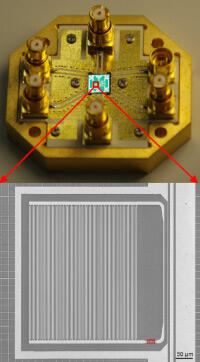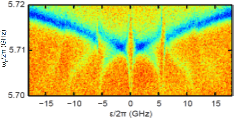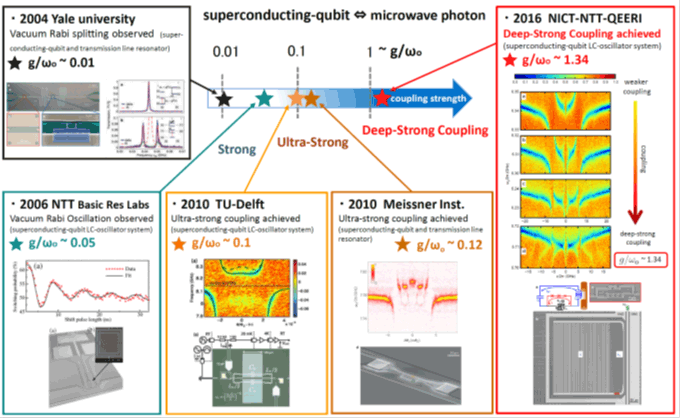Microsoft ends support for Internet Explorer on June 16, 2022.
We recommend using one of the browsers listed below.
- Microsoft Edge(Latest version)
- Mozilla Firefox(Latest version)
- Google Chrome(Latest version)
- Apple Safari(Latest version)
Please contact your browser provider for download and installation instructions.
October 11, 2016
National Institute of Information and Communications Technology
Nippon Telegraph and Telephone Corporation
The Qatar Environment and Energy Research Institute
Stable Molecular State of Photons and Artificial Atom Discovered
- New state may contribute to the development of quantum technologies based on light-matter interaction -
Summary
- A new state of a superconducting artificial atom dressed with virtual photons is discovered
- It provides a clear example for a forty-year-old problem in atomic physics
- It may contribute to the development of quantum technologies such as quantum communication or quantum metrology
Researchers at the National Institute of Information and Communications Technology (NICT, President: Dr. Masao Sakauchi), in collaboration with researchers at the Nippon Telegraph and Telephone Corporation (NTT, Representative Member of the Board and President, Mr. Hiroo Unoura) and the Qatar Environment and Energy Research Institute (QEERI, Acting Executive Director: Dr. Marwan Khraisheh) have discovered qualitatively new states of a superconducting artificial atom dressed with virtual photons. The discovery was made using spectroscopic measurements on an artificial atom that is very strongly coupled to the light field inside a superconducting cavity. This result provides a new platform to investigate the interaction between light and matter at a fundamental level, helps understand quantum phase transitions and provides a route to applications of non-classical light such as Schrödinger cat states. It may contribute to the development of quantum technologies in areas such as quantum communication, quantum simulation and computation, or quantum metrology.
This result will be published online in the October 11 issue of the journal Nature Physics.
Background and Challenges
The indispensable technologies in modern life such as a time system measured by an atomic clock and a secure and energy-efficient communications system are based on the fundamental science of the interaction between light and matter at the single-photon level. The absorption and emission of light from any device is explained based on the interaction of light and atoms. A fundamental question in atomic physics, "How strong can the coupling of light and an atom be?" has not been answered in spite of years of research, because it is not easy to find appropriate methods to realize very strong coupling.
It was predicted over forty years ago that if the coupling is extremely strong a qualitatively new lowest energy state (the ground state) of light and an atom should be realized. A debate soon started as to whether this prediction would still apply when realistic conditions are considered. A few years ago, our collaborator at QEERI, Dr. Sahel Ashhab, performed theoretical investigations and identified desirable conditions for achieving this new state using superconducting circuits.
 Figure 1 Experimental device
Figure 1 Experimental deviceThe chip mounted on a sample holder (top), and a laser microscope image of the circuit comprising a superconducting qubit (red rectangle) and oscillator.
Achievements
In the experiment, we used a microfabricated superconducting harmonic oscillator and a superconducting artificial atom (quantum bit or qubit) whose electronic states behave quantum mechanically, just like a natural atom. By carefully designing a superconducting persistent-current qubit interacting with an LC harmonic oscillator that has a large zero-point fluctuation current via a large shared Josephson inductance (see Fig. 1, Fig. 3), we found the new ground state as predicted theoretically (see Fig. 2).
The total energy of the qubit and the oscillator is the sum of the photon energy in the oscillator, the qubit energy, and the coupling energy binding the photons to the qubit. Taking advantage of the macroscopic quantum system, we could realize circuits with coupling energy larger than both the photon energy and the qubit energy. This situation is sometimes called 'deep strong coupling' (see Fig. 4).
In addition, we have observed that the transitions between energy levels are governed by selection rules stemming from the symmetry of the entangled energy eigenstates, including the ground state.
 Figure 2 Spectrum of the new states
Figure 2 Spectrum of the new statesTransmission spectrum as a function of the probe photon frequency (vertical) and the bias energy of the qubit (horizontal). The main features of the spectrum can be understood if and only if we assume the existence of a stable molecular state of photons and the artificial atom.
Prospect
We plan to test whether deep strong coupling is possible or not using more than one superconducting artificial atom (qubit), which remains a question of debate. We will also try to actively manipulate this new molecular state of photons and artificial atoms, for example, to observe and control the dynamics of photon absorption and emission, and to demonstrate new methods of entanglement generation.
About NICT
As Japan's sole National Research and Development Agency specializing in the field of information and communications technology, the National Institute of Information and Communications Technology (NICT) is charged with promoting the ICT sector as well as research and development in ICT, which drives economic growth and creates an affluent, safe and secure society. For more information, please visit http://www.nict.go.jp/en/index.html
About NTT
NTT carries out basic research and development activities at three laboratory groups in a wide range of fields, including some of the most advanced ICT research in the world. In the interest of creating a "new world of communication brought about by sharing of contextualized knowledge" in a "broadband and ubiquitous society", NTT is undertaking R&D to create new communication services and to foster foundational technologies that will realize communication networks to support these services. Moreover, NTT is also actively engaging in research on cutting-edge and basic technologies that look to the next decade. For more information, please visit http://www.nict.go.jp/en/index.html
About QEERI
The Qatar Environment and Energy Research Institute (QEERI) is part of Hamad Bin Khalifa University, a member of Qatar Foundation for Education, Science and Community Development. As a national research institute, QEERI plays a leading role addressing the national Energy and Water Security Grand Challenges through Research and Development (R&D). Aligned with the Qatar National Vision 2030's strategy of transforming the State into a diverse and sustainable knowledge-based economy, QEERI's water R&D program is developing innovative technologies in water desalination and treatment; water quality and reuse; aquifer recharge; and climate change and atmospheric science. QEERI's energy R&D focuses on Solar Photovoltaics (PV), energy storage and smart grids. For more information, please visit http://www.qeeri.org.qa/
Information of the article
Nature Physics (DOI: 10.1038/NPHYS3906)
| URL | http://www.nature.com/nphys/index.html |
|---|---|
| Title | Superconducting qubit-oscillator circuit beyond the ultrastrong-coupling regime |
| Authors | Fumiki Yoshihara, Tomoko Fuse, Sahel Ashhab, Kosuke Kakuyanagi, Shiro Saito and Kouichi Semba |
Author contributions
All authors contributed extensively to the work presented in this paper. F.Y., T.F. and K.S. carried out measurements and data analysis on the coupled flux qubit LC-oscillator system. F.Y. and T.F. designed and F.Y., T.F. and K.K. fabricated the flux qubit and associated devices. T.F., F.Y., K.K., S.S. and K.S. designed and developed the measurement system. S.A. provided theoretical support and analysis. F.Y., T.F., S.A. and K.S. wrote the manuscript, with feedback from all authors. K.S. designed and supervised the project.
Author affiliations
| NICT | Kouichi Semba, Fumiki Yoshihara, Tomoko Fuse |
|---|---|
| NTT | Shiro Saito, Kosuke Kakuyanagi |
| QEERI | Sahel Ashhab |
Acknowledgements
This work was supported in part by the Scientific Research (S) Grant No.25220601 by the Japanese Society for the Promotion of Science (JSPS).
Appendix
Superconducting circuit used in the experiment
- Circuit diagram. A superconducting flux qubit (red and black) and a superconducting LC oscillator (blue and black) are inductively coupled to each other by sharing a tunable inductance (black).
- Laser microscope image of the lumped-element LC oscillator inductively coupled to a coplanar transmission line.
- Scanning electron microscope image of the qubit and the coupler junctions located at the red rectangle in image b. The coupler, consisting of four parallel Josephson junctions, is tunable via the magnetic flux bias through its loops.
Highlight of the progress of the field
 Figure 4 In the past 12 years, the coupling of superconducting qubits and photons has become more than 100 times stronger. In the present experiment, the deep-strong-coupling (g/ωo >1) regime has been achieved, and a qualitatively new ground state (stable molecular state of photons and the artificial atom) has been discovered (see '2016 NICT-NTT-QEERI' of the right side of the figure.).
Figure 4 In the past 12 years, the coupling of superconducting qubits and photons has become more than 100 times stronger. In the present experiment, the deep-strong-coupling (g/ωo >1) regime has been achieved, and a qualitatively new ground state (stable molecular state of photons and the artificial atom) has been discovered (see '2016 NICT-NTT-QEERI' of the right side of the figure.).
Contact information
 Technical Contact
Technical Contact
Kouichi Semba
Macroscopic Quantum Physics Project
Frontier Research Laboratory
Advanced ICT Research Institute
NICT
Tel: +81-42-327-7611
E-mail: mqp_staff@ml.nict.go.jp
Shiro Saito
Hybrid Nanostructure Physics Research Group
NTT Basic Research Laboratories, NTT
Tel. +81-46-240-3327
E-mail: saito.shiro@lab.ntt.co.jp
Sahel Ashhab
Theory, Modeling and Simulation Group
QEERI
Tel: +974-4454-6378
E-mail: sashhab@qf.org.qa
 Technical Contact
Technical Contact
Press Office
Public Relations Department
NICT
Tel: +81-42-327-6923
E-mail: publicity@nict.go.jp
Public Relations
Science and Core Technology Laboratory Group
Nippon Telegraph and Telephone Corporation
E-mail: a-info@lab.ntt.co.jp
QEERI
Tel: +974-4454-1714
Fax: +974-4454-1528
E-mail: qeeri-communication@qf.org.qa
Information is current as of the date of issue of the individual press release.
Please be advised that information may be outdated after that point.
NTT STORY
WEB media that thinks about the future with NTT











